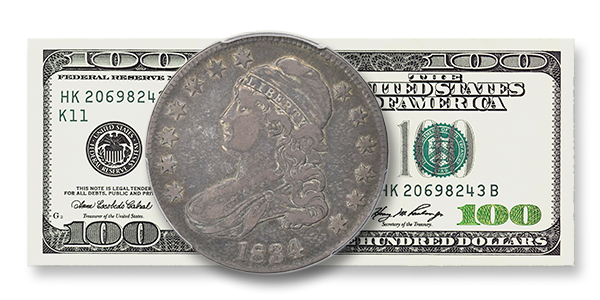
News and Analysis regarding scarce coins, coin markets, and the coin collecting community #309
A Weekly CoinWeek Column by Greg Reynolds….
For less than $100 per coin, a collector may assemble a complete type set of U.S. silver coins of series that began after 1806 and before 1900, except silver dollars. In addition to multiple design types of dimes, quarters, and half dollars, respectively, such a set would include Three Cent Silvers, half dimes, and a Twenty Cent piece.
An extensive type set of 19th century silver series, even if incomplete, is itself important, interesting, historically significant and solidly grounded in the culture of coin collecting in the U.S. Collecting such coins for less than $100 each is a sound practice, from a logical perspective, given prevailing market values overall for classic U.S. coins.
Silver dollars and Trade Dollars are beside the present theme. It would not be practical to acquire pleasant, pre-1874 silver dollars for less than $100 each.
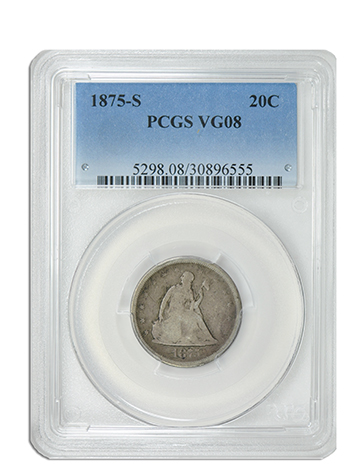
Herein, I am referring to coins that experts find to be gradable, coins that do not have serious problems. In some cases, one severe gash may prevent a coin from being assigned a numerical grade. In other cases, a non-gradable coin may have multiple, very severe problems.
A truly gradable Twenty Cent piece would not be hard to acquire for less than $100. There is just one design type and all were minted from 1875 to 1878. Several PCGS or NGC graded Good-04 to Very Good-08 1875-S Twenty Cent pieces have sold over the Internet over the last three years for amounts between $50 and $100 each. For example, about a year ago, the firm of “GreatCollections” sold a PCGS graded VG-08 1875-S Twenty Cent piece for $81.17.
Type Coins & Type Sets
A ‘type coin’ represents a particular design type of regular issue U.S. coins. Only one representative of each design type is needed for a complete type set relating to a particular time period, metal, denomination or other theme. Collectors often combine themes, like a type set of silver quarters and half dollars, or a type set of all Liberty Seated silver coins.
Usually, a collector building a type set will select coins that are among the least scarce of each design type. For less than $100 per coin, it would be practical to assemble a complete type set of gradable, 19th century silver series, which began after 1806, excluding silver dollars. After such a goal is fulfilled, there are several logical avenues for further building a collection.
A collector could then add post-1806, copper and nickel type coins to the set, all of which are obtainable for less than $100 each. Last week, relatively inexpensive Classic Head large cents, which date from 1808 to 1814, were discussed. Some large cents that cost less than $100 each are mentioned therein. (References may be accessed by clicking on words in blue.)
For slightly more than $100, a gradable Trade Dollar might be added to a type set. This is a ‘one dollar’ silver coin that is heavier than a silver dollar and was originally intended to facilitate trade with societies in the Orient.
Certainly, for less than $300 per coin, Good-04 grade representatives of both major types of Liberty Seated silver dollars would further a type set of 19th century silver coins. A collector could include silver types that began prior to 1806 and thus spend substantially larger amounts for decent type coins. There is no need, however, to change directions or to spend more money per coin.
After forming a type set, a collector could focus on Capped Bust half dimes or Barber dimes and continue to spend less than $100 for each coin while collecting ‘by date’ rather than ‘by type.’ Even a limited set ‘by date’ of Three Cent Silvers, from 1851 to 1862, is a viable option, while spending less than $100 per coin.
Three Cent Silvers
U.S. Three Cent Silver coins were minted from 1851 to 1873. ‘Type 1’ Three Cent Silvers consist of 75% silver and 25% copper, the only U.S. coins made of such an alloy. Most “U.S. silver coins” are 90% silver and 10% copper. Before 1837, however, U.S. silver coins were specified to be about 89.24% silver (1485/1664). ‘Type 2’ and ‘Type 3’ Three Cent Silvers are 90% silver.
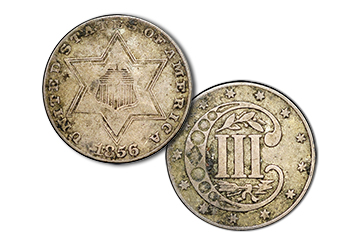
A ‘Type 1’ Three Cent Silver in Extremely fine-40 grade would be likely to retail for less than $100. A Good-04 grade piece could probably be obtained for around $20. Very Fine grade ‘Type 2’ and “Type 3” coins could easily be acquired for less than $100 each, maybe for less than $70. ‘Type 3’ Three Cent Silvers were introduced in 1859.
Fine-12 or higher grade representatives of all Three Cent Silvers may be purchased for less than $100 each. In November 2013, a NGC graded Fine-15 1856 from the famous Eric Newman Collection was auctioned in New York for $79.
Half Dimes
Unlike nickels, half dimes are silver coins. Five cent nickels consist of 25% nickel and 75% copper. Half dimes before 1837 were specified to be 89.24% silver. Most U.S. half dimes are 90% silver. Half dimes never contained any nickel.
Although there are nine design types of half dimes, just six of them date from after 1806: Capped Bust (1829-37); Liberty Seated, No Stars (1837-38); Liberty Seated, With Stars, No Drapery (1838-40); Liberty Seated, With Stars, With Drapery, No Arrows (1840-1859, except 1854-55); Liberty Seated, With Arrows (1853-55); 9) Liberty Seated, Legend on Obverse (front) – 1860-73. Half dimes were last minted in 1873.
A VF-20 grade Capped Bust half dime could be found for less than $100. In March 2015, the firm of “GreatCollections” sold a NGC graded VF-20 1830 for $69.92. A Fine-12 grade 1837 ‘No Stars’ Liberty Seated half dime and could be acquired for less than $100.
In 2012, Heritage auctioned a PCGS graded Extremely Fine-40 1840 ‘No Drapery half dime for $69. Extremely Fine-40 or better grade, representatives of the remaining three types of half dimes, all of which are variants of the Liberty Seated design, could be easily purchased for less than $100 each.
Dimes
Excluding earlier Draped Bust issues, a 19th century type set of dimes requires just nine coins: Capped Bust – ‘Large’ (1809-28); Capped Bust – ‘Small’ (1828-37); Liberty Seated – No Stars (1837-38); Liberty Seated with Stars and ‘No Drapery’ on Obverse (1838-40); Liberty Seated with Stars and Drapery on Obverse (1840-1853, 1856-60); Liberty Seated – Arrows & Stars on Obverse (1853-55); Liberty Seated – Legend on Obverse (1860-73, 1875-91); Liberty Seated – Arrows & Legend on Obverse. 1873-74; Barber 1892-1916.
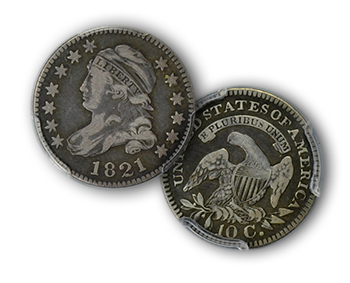
A ‘Large Size’ Capped Bust dime in Fine-12 grade could be obtained for less than $100. In 2013, GreatCollections sold a PCGS graded Fine-15 1821 for $85.35. In 2012, Heritage sold a NGC graded Fine-12 1821 for $74.
In 1828, the design of Capped Bust dimes was changed to a significant extent. A Very Fine-20 grade dime from the 1830s could be purchased for a little less than $100. On Nov. 29, “GreatCollections” sold a PCGS graded VF-30 1835 for $97.90. In March, this same firm sold a PCGS graded VF-20 1834, with CAC approval, for $96.55. A whole set ‘by date’ of this type, which dates from 1828 to 1837, could be easily completed for less than $100 each.
An 1837 ‘No Stars’ Liberty Seated dime might cost nearly $100 in Fine-12 grade. For less than $90 per coin, VF-25 to -35 grade representatives of all the other design types of Liberty Seated dimes could be purchased without difficulty.
There is only one design type of Barber dimes (1892-1916). Although an uncirculated (‘MS’) coin could be found for less than $100, it would probably not be a great uncirculated coin. A pleasantly toned, choice AU-55 or -58 grade Barber dime might be more soothing. In February 2015, Heritage sold a PCGS graded AU-58 1892 dime for $62.
Quarters
Excluding Draped Bust, Heraldic Eagle quarters (1804-07), a 19th century type set of quarters requires just nine coins: Reich Capped Bust – “Large” (1815-28); Kneass Capped Bust – “Small” (1831-38); Liberty Seated, No Drapery, No Motto (1838-40); Liberty Seated, With Drapery, No Motto (1840-53 and 1856-65); E) Liberty Seated, Arrows & Rays (1853 only); F) Liberty Seated, Arrows, No Motto, No Rays (1854-55); Liberty Seated, Motto (1866-73 and 1875-91); Liberty Seated, Arrows, Motto (1873-74); Barber (1892-1916).
A Reich Capped Bust quarter (1815-28), the so called ‘Large Size’ type, in AG-03 grade could be acquired for less than $90. A complete set ‘by date’ of Kneass Capped Bust quarters (1831-38) in Good-04 to -06 grades could probably be assembled for less than $100 per coin.
The Reich Capped Bust quarter design and the Kneass Capped Bust quarter are artistically very different. It would not make sense to refer to these as being of the same general design type.
Unlike Liberty Seated half dimes and dimes, all Liberty Seated quarters have stars on the obverse. A ‘No Drapery’ Liberty Seated quarter in Fine-12 grade could be found for less than $100. Fine-12 to VF-35 grade representatives of all other types of Liberty Seated quarters are readily available for less than $100 each. In a somewhat recent fixed price list, Jack Beymer offered an 1844 that he graded as “VF-30” for $92.50. I never saw it. On Oct. 4, 2015, GreatCollections sold a PCGS graded EF-40 1861 for $77.
As a one-year type with both arrows and rays, 1853 quarters are popular. On Aug. 18, 2015, Heritage sold a NGC graded VF-30 1853 for $79. On April 9, 2015, GreatCollections sold a PCGS graded VF-25 1853 for $62.70.
There are many dates in the series of Barber quarters that retail for around $80, or less, in Extremely Fine-40 grade. I suggest an 1892, as this is the first year of the series and many attractive 1892 quarters survive.
Half Dollars
Reich Capped Bust half dollars were minted from 1807 to 1836. These are typically referred to as ‘lettered edge’ coins, as half dollars of the next type each have a ‘reeded edge.’
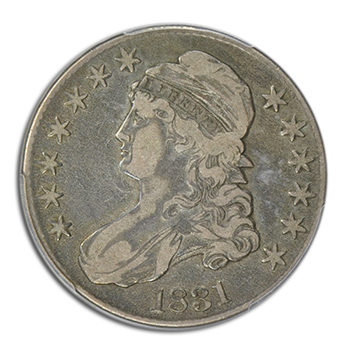
It is best to refer to the ‘lettered edge’ pieces as Reich and the ‘reeded edge’ Capped Bust halves as Gobrecht for at least two reasons. First, as both are of Capped Bust designs, it is logical and illuminating to name each after its respective designer. John Reich and Christian Gobrecht are both very famous and influential designers in the history of U.S. coinage. Secondly, the different kind of edge is just one of several distinctions. The artistic aspects of the designs are very different.
Even if they had the same edge structures, Reich and Gobrecht Capped Bust halves would certainly be two different design types. There is not a need to see an edge or a year (“date”) to identify the design type of one of either. It is thus misleading and counter-educational to give the impression that the main difference between Reich Capped Bust halves and Gobrecht Capped Bust halves is the kind of edge.
Many Reich Capped Bust halves that have been PCGS or NGC graded as Fine-12 are available for less than $100 each, as are quite a few VF-20 grade pieces. Two days ago, GreatCollections sold a PCGS graded Fine-12 1821 for $90.21 and a PCGS graded VF-30 1835 for $73.70.
An 1838 or 1839 Gobrecht Capped Bust (“reeded edge”) half in VG-10 grade retails for less than $100. Most of these are not certified. In December 2012, GreatCollections sold a PCGS graded VG-10 1839 Gobrecht half for $82.50
Generally, representatives of all design types of Liberty Seated halves are available for less than $100 each, usually in Fine to VF grades. A Barber half dollar in Fine-15 grade could be easily found for less than $75.
Results of auctions and Internet sales provide ideas of market values for coins. I have not seen the coins mentioned and I am not recommending specific coins here. Retail prices will frequently be higher than auction results. Certified grades should not be taken too seriously. Collectors are encouraged to learn about coins and to consult experts.
Acquiring coins for less than $100 each does not involve much downside risk. Many classic U.S. coins are worth much more.
Collecting 19th century silver type coins, representing series that started after 1806, is not difficult. There are many, pleasing, naturally toned coins to be found for less than $100 each.
©2015 Greg Reynolds




